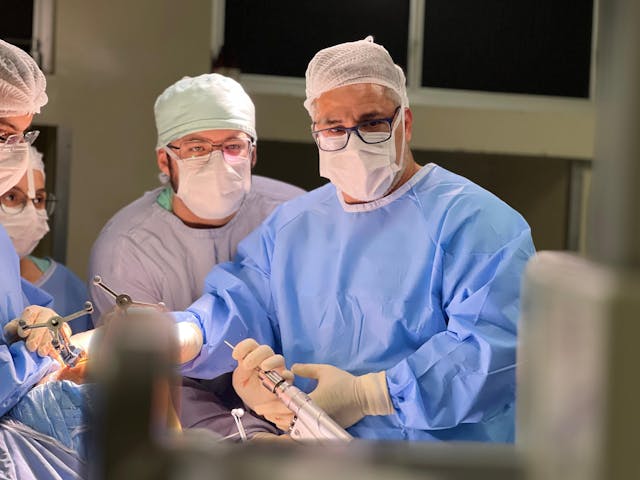Introduction
Amputation, the surgical removal of a limb, has long been a drastic measure employed to manage severe trauma or untreatable limb conditions. However, significant advancements in medical technology are shifting this paradigm, offering innovative solutions that are increasingly making amputation a last resort rather than a first option. This transformation is driven by a convergence of breakthroughs in regenerative medicine, advanced prosthetics, and minimally invasive surgical techniques. The result is a renewed hope for patients facing limb loss, offering them pathways to limb preservation and enhanced quality of life.
Regenerative Medicine: The Promise of Limb Regeneration
The field of regenerative medicine is witnessing remarkable strides in its ability to repair and regenerate damaged tissues. Researchers are exploring various approaches, including the use of stem cells, growth factors, and biomaterials, to stimulate the body’s natural healing processes and promote tissue regeneration. These therapies hold the potential to repair severely damaged limbs, avoiding the need for amputation in cases that were previously considered irreversible. Early clinical trials have shown promising results, although further research is needed to translate these successes into widely available treatments.
Significant progress is also being made in understanding the complex molecular mechanisms that govern tissue regeneration. By deciphering these mechanisms, scientists hope to develop targeted therapies that can precisely stimulate the regeneration of specific tissues, such as bone, muscle, and nerve, in injured limbs. This granular approach promises to be more effective and less prone to complications than broader regenerative approaches. This targeted approach is proving to be a game changer, offering more precise and effective solutions compared to previous broad-spectrum methods.
Advanced Prosthetics: Restoring Function and Improving Quality of Life
Simultaneously, advancements in prosthetics are blurring the lines between biological limbs and artificial replacements. The development of sophisticated sensors, advanced materials, and intuitive control systems has led to the creation of prosthetics that are not only aesthetically pleasing but also remarkably functional. These “smart” prosthetics can detect and respond to subtle muscle signals, allowing amputees to perform complex movements with greater precision and control than ever before. This increased functionality significantly improves the quality of life for amputees, allowing them to regain independence and participate more fully in daily activities.
Beyond functionality, research is focused on creating more intuitive and seamless integration between the prosthetic and the nervous system. This includes exploring brain-computer interfaces that allow direct control of prosthetics through thought alone, offering a level of control that is unprecedented in prosthetic technology. This ongoing development aims to create prosthetics that feel as natural and integrated as biological limbs, significantly enhancing both physical and psychological well-being.
Minimally Invasive Surgical Techniques: Preserving Limb Integrity
Minimally invasive surgical techniques are revolutionizing the treatment of limb injuries and conditions. These techniques, such as arthroscopy and microsurgery, allow surgeons to perform complex procedures with smaller incisions, resulting in less trauma to the surrounding tissues. This results in faster recovery times, reduced pain, and a lower risk of complications compared to traditional open surgery. In cases where amputation was previously considered necessary, minimally invasive surgery often provides a viable alternative, enabling the preservation of the limb and reducing the need for amputation.
The use of advanced imaging technologies, such as CT scans and MRI, also plays a critical role in guiding minimally invasive procedures. These technologies allow surgeons to visualize the injury with greater precision, enabling them to perform more targeted interventions and minimizing the risk of damage to healthy tissues. Furthermore, the development of new surgical tools and instruments is continuously improving the precision and effectiveness of minimally invasive techniques, expanding their applicability to a wider range of limb injuries and conditions.
Targeted Drug Therapies: Combating Underlying Conditions
Many cases leading to amputation stem from underlying medical conditions such as diabetes or severe infections. Advances in targeted drug therapies are offering new ways to manage these conditions effectively, reducing the likelihood of complications that might lead to limb loss. Improved control of blood sugar levels in diabetics, for instance, can significantly reduce the risk of peripheral artery disease and diabetic foot ulcers, two major causes of lower limb amputation. Similarly, advancements in antibiotic development are improving the treatment of severe infections that can compromise limb viability.
The development of personalized medicine further contributes to this progress. By tailoring treatment plans to individual patients’ genetic profiles and medical histories, doctors can optimize treatment strategies and minimize the risk of complications. This personalized approach ensures that patients receive the most effective therapy possible, preventing disease progression and reducing the risk of irreversible damage that necessitates amputation. Precision medicine is becoming a crucial aspect of proactive limb preservation strategies.
Conclusion
The convergence of advancements in regenerative medicine, advanced prosthetics, minimally invasive surgical techniques, and targeted drug therapies is transforming the landscape of limb preservation. While amputation remains a necessary option in some cases, these technological leaps are rapidly making it a last resort rather than a first choice. This translates to improved patient outcomes, enhanced quality of life for amputees, and a renewed sense of hope for individuals facing the prospect of limb loss. The future of limb preservation appears brighter than ever before, driven by the relentless pursuit of innovative solutions.
